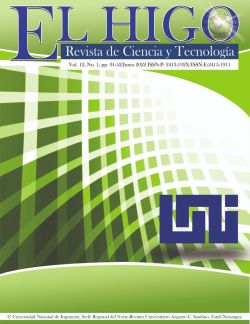Structural equation models (SEM) and their application in education
DOI:
https://doi.org/10.5377/elhigo.v12i1.14524Keywords:
Structural models, Regression, Educational researchAbstract
Structural equation modeling (SEM) is a statistical methodology that takes a confirmatory (hypothesis testing) approach to the analysis of a structural theory that relates to some phenomenon. Typically, this theory represents causal processes, which generate observations in multiple variables (Bentler, 1988). The term structural equation model conveys two important aspects of the procedure: (a) that the causal processes under study are represented by a series of structural equations, regression; and (b) that these structural relationships can be modeled graphically to allow a clearer conceptualization of the theory under study (Byrne, 2010). These structural equation models were born from the need to provide greater flexibility to regression models. They are less restrictive than regression models because they allow measurement errors to be included in both the criterion (dependent) variables and the predictor (independent) variables. The SEM could be thought of as several factor analysis models that allow for direct and indirect effects between factors. The great advantage of this type of models is that they allow proposing the type and direction of the relationships that are expected to be found between the various variables contained in it, in order to subsequently estimate the parameters that are specified by the proposed theoretical relationships. In this article, the characteristics and phases of structural equation models are exposed, such as the construction stages, the interpretation of results, the graphical representation and the types of variables used. The possible use of these models in educational research at the university level is also addressed.
Downloads
References
Batista-Foguet, J. M., y Coenders, G. (2000). Modelos de Ecuaciones Estructurales. La Muralla.
Bentler, P. (1988). Causal Modeling via Structural Equation Systems. (C. R. In: Nesselroade J.R., Ed.) Springer, Boston, MA. . doi:https://doi.org/10.1007/978-1-461
Bentler, P. (1995). EQS structural equations program manual. Encino, CA: Multivariate.
Byrne, B. (2010). Structural equation modeling with AMOS: basic concepts, applications, and programming. Routledge.
Casas Guillen, M. (2002). Los modelos de ecuaciones estructurales y su aplicación en el Índice Europeo de Satisfacción del Cliente. Revista Electrónica de Comunicaciones y Trabajos de ASEPUMA.
Castro, M., y Lizasoain, L. (2012). Las técnicas de modelización estadística en la investigación educativa: minería de datos, modelos de ecuaciones estructurales y y modelos jerárquicos lineales. revista española de pedagogía(251), 131-148. Retrieved from https://www.jstor.org/stable/23766443?seq=1#metadata_info_tab_contents
Cupani, M. (2012). Análisis de Ecuaciones Estructurales: conceptos, etapas de desarrollo y un ejemplo de aplicación. Revista Tesis, 186-199.
Escobedo, M. T., Hernández, J. A., Estebané, V., y Martínez, G. (2016). Modelos de ecuaciones estructurales: Características, fases, construcción, aplicación y resultados. Ciencia & trabajo, 18(55), 16-22. doi:https://dx.doi.org/10.4067/S0718-24492016000100004
Fernández, V. (2004). Relaciones encontrads entre las dimiensiones de la estructura organizativa y los componentes del constructo "capacidad de absorción" el caso de empresas ubicadas en el territorio español. Universitat Politècnica de Catalunya.
Ferrando, P. J., y Anguiano-Carrasco, C. (2010). El análisis factorial como técnica de investigación en psicología. . Papeles del Psicológo,, 31(1), 18-33.
Hernández, J. L. (2016). Modelos de ecuaciones estructurales aplicados al análisis de fatiga. Revista Ciencia y Salud , 14, 69-80.
Hu, L.-t., y Bentler, P. M. (1998). Fit indices in covariance structure modeling: Sensitivity to underparameterized model misspecification. Psychological Methods, 4, 424–453. doi:https://doi.org/10.1037/1082-989X.3.4.424
Iglesias, D., Jiménez, R., Villar, F. d., y Cervelló, E. M. (2004). Aplicación de modelos de ecuaciones estructurales al estudio de la motivación de los alumnos en las clases de Educación Física. Revista de educación(335), 371-382.
Jöreskog, K., y Sörbom, D. (1996. ). LISREL 8: User’s reference guide. . Chicago: Scientific Software International.
Kaplan, D. (2009). Structural Equation Modeling (Vol. 2nd Edition). doi:https://dx.doi.org/10.4135/9781452226576
Kline, R. (2005). Principles and Practice of Structural Equation Modeling (Fourth Edition ed.). Guilford Press.
Lara, A. (2014). Introducción a las acuaciones estructurales en AMOS y R. Retrieved from https://masteres.ugr.es/moea/pages/curso201314/tfm1314/tfm-septiembre1314/memoriamasterantonio_lara_hormigo/!
Manzano, A. P. (2017). Introducción a los modelos de ecuaciones estructurales. Investigacion en educación media, 7(25), 67-72.
Peñalosa, E., y Castañeda, S. (2012). Identificación de Predictores para el aprendizaje efectivo en línea, un modelo de ecuaciones estructurales. Revista Mexicana de Investigación Educativa, 17(52), 247-285. Retrieved from https://www.proquest.com/docview/1014284508/fulltextPDF/A625FA3A3654E90PQ/4?accountid=168360
Rodriguez, H. Y., y Galvis, J. J. (2020, septiembre). Un acercamiento a la correlación entre habilidades tecnológicas de los docentes y su intención de uso de la tecnología en la enseñanza en el aula secondtitle. Comunicaciones en Estadística, 13(1), 15-30. Retrieved from https://www.proquest.com/docview/2568681949/A625FA3A3654E90PQ/5?accountid=168360
Ruiz, M., Pardo, A., y San Martín, R. (2010). Modelos de ecuaciones estructurales. Papeles del Psicólogo., 31(1), 34-35.
Salgado, L. (2009). Instrumentos de marketing aplicados a la compra de productos ecologicos: un caso de estudio entre Barcelona, España y La Paz, México. Barcelona: Universitat de Barcelona.
Samperio, V. M. (2019, abril). Ecuaciones estructurales en los modelos educativos: características y fases en su construcción. apertura, 11(1), 90-103. doi:10.32870/Ap.v11n1.1402
Vargas, M. M., y Montero, E. (2016). Factores que determinan el rendimiento académico en Matemáticas en el contexto de una universidad tecnológica: aplicación de un modelo de ecuaciones estructurales. Universitas Psychologica, 15(4). doi:10.11144/Javeriana.upsy15-4.fdra
Vazquez Molina, J. (2012). Modelos de ecuaciones estructurales en Psicología. Universitat de Valéncia.
Downloads
Published
How to Cite
Issue
Section
License
Copyright (c) 2022 Universidad Nacional de Ingeniería

This work is licensed under a Creative Commons Attribution-NonCommercial-NoDerivatives 4.0 International License.







